Its notably attributes are the clearness of the ingredients, the refreshing qualities of the dishes and the tenderness and crispness of the plates prepares. It emphasizes flavors which are clear but not light, refreshing but not common, tender but not crude, and shiny but not oily. Cantonese recipes stress flavors of the seasons: in summer and autumn the dishes pursue clarity and in winter and spring there is more substance.
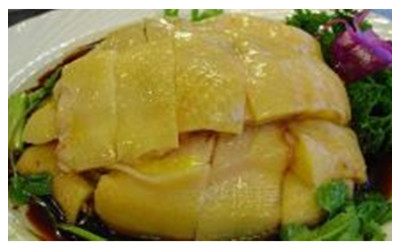 White cut chicken
White cut chicken
White cut chicken is a traditional, common chicken dish in Cantonese Cuisine with great presentation and taste. It is easy-to-make and cooked in its entirety in hot water without other ingredients to keep its original flavor. White cut chicken is light and delicious. The chicken’s skin is light colored, nearly white and the meat is quite tender, moist, and flavorful. A condiment usually accompanied by combining finely minced ginger, green onion, salt and hot peanut oil. Additional dips can be spicy mustard, hoisin sauce, soy sauce, oyster sauce, or chili pepper sauce. The famous Panxi Restaurant white cut chicken was once awarded the Jingding Award for high quality products by the Ministry of Commerce.
Rice noodle roll
Rice noodle roll is a special snack originated in Guangdong. Early in the late Qing Dynasty, rice noodle roll was sold on the street in Guangzhou. At that time, there were two types of rice noodle roll, the salty one and the sweet one. The stuffing of the salty rice noodle roll mainly includes pork, beef, shrimp meat and pork liver, while that of the sweet one mainly includes sugar-soaking vegetables and fruits and stir-fried sesame. Rice noodle roll is also known as steamed rice roll or chee cheong fun where chee cheong means pig intestine, and fun means noodle; this is because the noodle is rolled more tightly and resembles the small intestine of a pig. Rice noodle roll in Chaoshan area is different from the traditional Cantonese style one. Chaoshan rice noodle roll has many kinds of stuffing and condiment, while traditional Cantonese style one has only one or two kinds of stuffing and soybean sauce as the condiment, so its flavor is lighter and purer.
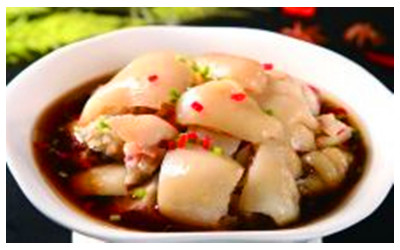 Baiyun Trotter
Baiyun Trotter
This dish is reputed to have originated on the
Baiyun Mountain and hence, gets its name. In this dish the bone and flesh on the trotter are easily separated and its skin being tender and the flesh crisp. This dish goes very nicely with wine and is said to improve the complexion and maintain a sense of youthfulness.
Sweet and sour pork
Called “goo lou yok” in Cantonese dialect, sweet and sour pork is a classic dish of the Han Nationality originated in Guangdong. The dish consists of deep-fried pork and sweet and sour sauce and it is one of the most popular Chinese dishes in western countries. Many restaurants in China Towns all over the world often serve sweet and sour pork along with rice or fried rice. It is said that the name of “goo lou yok” came from two stories. In the first story, as the dish is cooked with sweet and sour sauce, its fragrance makes people’s mouths water and couldn’t helping swallowing, and “goo lou” is the exact sound of swallowing. The second version gives credit to the long history of this dish for “goo lou” is a homonym in Chinese language that means “old and ancient”.
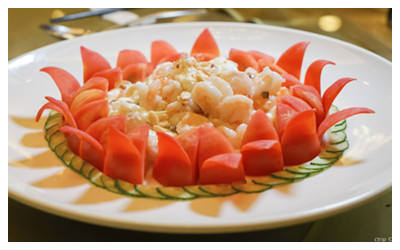 White boiled shrimp
White boiled shrimp
White boiled shrimp is a famous Cantonese dish of the Han nationality in
Guangzhou, Guangdong Province. Its main ingredient is shrimp which is boiled in hot water to preserve its original flavor of freshness, sweetness and tenderness. After peeled, the shrimp is then eaten with soy sauce. White boiled shrimp is fresh, tender and delicious.
"Hundred Flower" Fish Maw
Fish maw has soft bones and is white in color and has a fresh and tender taste. The fish maw, the air bladder of the fish, is the organ that allows fish to float and to sink. For this dish the air-dried maw is typically from sharks and giant salamanders and is one of the top four seafood dishes. Fish maws are produced in China's coastal areas, the most prominent of which is Guangdong's "Guang maw".
Snake Potage with Eight Delicacies
Guangzhou's snake restaurants have a long history and enjoy immense popularity. The "Snake King Fullness" Restaurant, the top snake restaurant in Guangzhou, is noted for its dishes prepared using various techniques. Snake Potage with Eight Delicacies, a classic dish offered by clients of this restaurant, features a strong fragrance and is effective in renowned for relieving rheumatic pains, eliminating dampness in the body, invigorating the spleen and replenishing energy.
Sliced Suckling Pig
This dish features a suckling pig prepared with a bright red, oily textured skin and tender meat. Its unique flavor has earned it wide popularity. Roasted suckling pig is one of the grandest dishes for the people of Guangdong and Guangxi Provinces and is served when entertaining guests at home or in a restaurant.
Guangzhou Wenchang Chicken
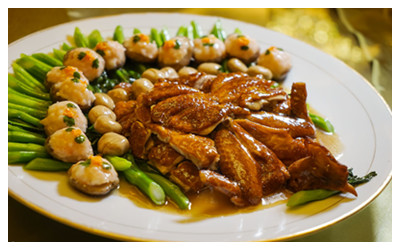
The word "Wenchang" in "Guangzhou Wenchang Chicken" has two historical references: First, the chicken used was originally a high-quality chicken from Wenchang County in Hainan Province; and Second, the first Guangzhou restaurant offering this dish was located on Wenchang Road in Guangzhou City. During the 1930s Guangzhou master chef Liang Ruijiang created this ingenious dish by removing the bones and boiling, steaming and frying the chicken meat with ham and chicken liver. By doing so, he made the best use of the ingredients and bypassed their disadvantages resulting in the perfect chicken dish. Over the past decades, Wenchang Chicken has gained popularity in
China and beyond. Today, it ranks among Guangzhou's top eight chicken dishes.

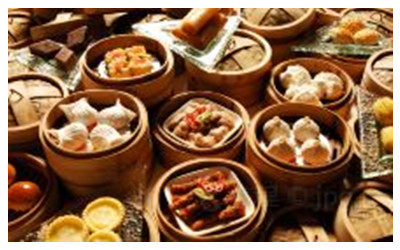 Guangzhou Cuisine, a branch of Guangdong Cusine, has evolved into its' unique form by integrating folk delicacies from throughout Guangdong Province, absorbing the strong points of all major Chinese cuisines and drawing on selected strengths of Western recipes. It is characterized by the diversity of the ingredients used, the rigor of their selection, the polished culinary skills applied and a seemingly endless variety of dishes. The Guangzhou Renowned Dishes and Delicacies Expo in 1956 featured more than 5,447 dishes as well as 815 dim sum platters and hundreds of snacks.
Guangzhou Cuisine, a branch of Guangdong Cusine, has evolved into its' unique form by integrating folk delicacies from throughout Guangdong Province, absorbing the strong points of all major Chinese cuisines and drawing on selected strengths of Western recipes. It is characterized by the diversity of the ingredients used, the rigor of their selection, the polished culinary skills applied and a seemingly endless variety of dishes. The Guangzhou Renowned Dishes and Delicacies Expo in 1956 featured more than 5,447 dishes as well as 815 dim sum platters and hundreds of snacks. White cut chicken
White cut chicken Baiyun Trotter
Baiyun Trotter White boiled shrimp
White boiled shrimp The word "Wenchang" in "Guangzhou Wenchang Chicken" has two historical references: First, the chicken used was originally a high-quality chicken from Wenchang County in Hainan Province; and Second, the first Guangzhou restaurant offering this dish was located on Wenchang Road in Guangzhou City. During the 1930s Guangzhou master chef Liang Ruijiang created this ingenious dish by removing the bones and boiling, steaming and frying the chicken meat with ham and chicken liver. By doing so, he made the best use of the ingredients and bypassed their disadvantages resulting in the perfect chicken dish. Over the past decades, Wenchang Chicken has gained popularity in China and beyond. Today, it ranks among Guangzhou's top eight chicken dishes.
The word "Wenchang" in "Guangzhou Wenchang Chicken" has two historical references: First, the chicken used was originally a high-quality chicken from Wenchang County in Hainan Province; and Second, the first Guangzhou restaurant offering this dish was located on Wenchang Road in Guangzhou City. During the 1930s Guangzhou master chef Liang Ruijiang created this ingenious dish by removing the bones and boiling, steaming and frying the chicken meat with ham and chicken liver. By doing so, he made the best use of the ingredients and bypassed their disadvantages resulting in the perfect chicken dish. Over the past decades, Wenchang Chicken has gained popularity in China and beyond. Today, it ranks among Guangzhou's top eight chicken dishes. Ask Questions ?
Ask Questions ?